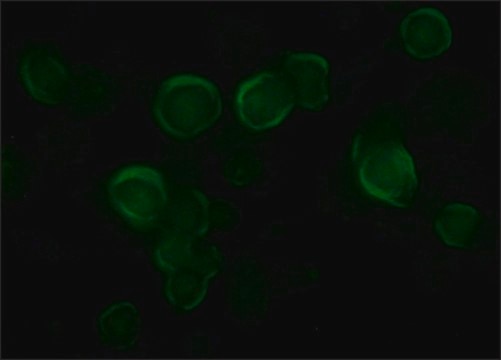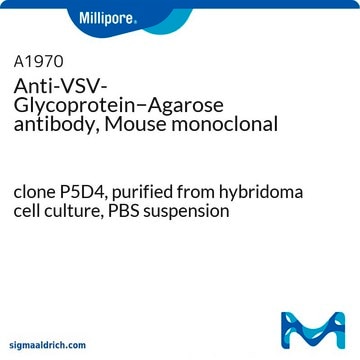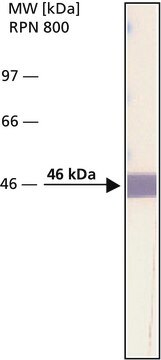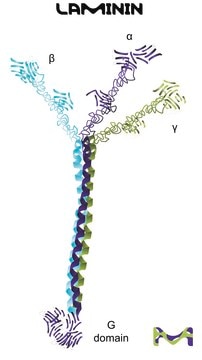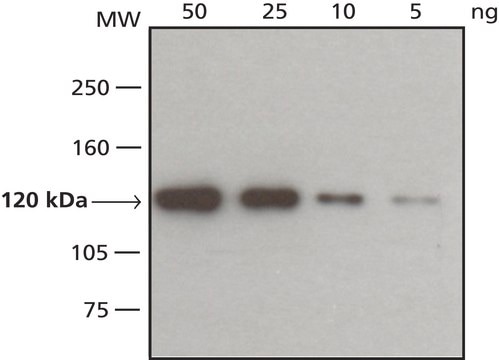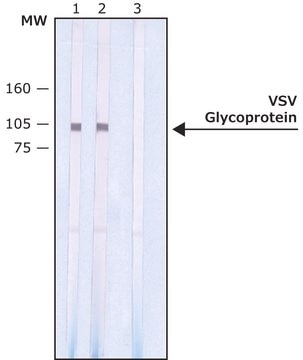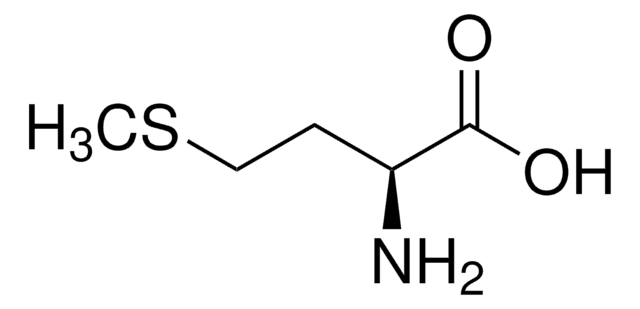General description
Monoclonal Anti-VSV Glycoprotein (mouse IgG1 isotype) is derived from the P5D4 hybridoma produced by the fusion of mouse myeloma cells and splenocytes from a BALB/c mouse immunized with a synthetic peptide of vesicular stomatitis virus glycoprotein (VSV-G), conjugated to keyhole limpet hemocyanin (KLH). VSV-G is a protein expressed on the surface of bullet shaped virions.
Specificity
The antibody recognizes an epitope containing the five carboxy-terminal amino acids of VSV Glycoprotein. In infected cells, the antibody localizes the immature forms of VSV-G in the rough endoplasmic reticulum (RER) and in the cisternae of Golgi complex, as well as mature VSV-G at the cell surface and in the budding virus. The antibody does not stain the secreted form of VSV-G which lacks the membrane and the cytoplasmic domain. This antibody has been used for studies on the role of the cytoplasmic domain on newly-synthesized VSV-G during transfer to the plasma membrane and cell surface, using micro-injected antibody, immunoblotting, immunoprecipitation, immunocytochemistry and immunoelectron microscopy. The antibody has been used for the detection, immunoprecipitation and immunocytochemical staining of exogenously introduced constructs tagged with the carboxyl-terminus of VSV-G. This tag does not interfere with the function of the studied protein and can be specifically recognized by the P5D4 antibody without cross-reaction with any endogenous protein.
Immunogen
synthetic peptide containing the 15 carboxy-terminal amino acids (497-511) of Vesicular Stomatitis Virus Glycoprotein (VSV-G), conjugated to KLH.
Application
A dilution of 1:1000 of Monoclonal Anti-VSV Glycoprotein-Cy3® antibody produced in mouse was used to detect VSV glycoprotein in pig sperms by immunofluorescence.
Monoclonal Anti-VSV Glycoprotein Cy3
™ antibody produced in mouse has been used:
- in studies applying
- microinjection of antibody
- immunoblotting
- immunoprecipitation
- immunocytochemistry
- immunoelectron microscopy.
Biochem/physiol Actions
The envelope of vesicular stomatitis virus (VSV) consists of a bilayer membrane with a single type of glycoprotein, the G-protein (VSV-G) which mediates attachment to the cell surface and induces pH-dependent fusion between viral and target membranes. The carboxyl terminus of the VSV-G protein which does not have any homology with cellular proteins, has been engineered into expression vectors as a tag. Proteins expressed with this tag may thus be detected and localized using an antibody reactive specifically against this epitope with no risk of cellular background staining.
The vesicular stomatitis virus (VSV) glycoprotein facilitates the entry of HIV into the CD4 T cells through endocytotic pathway. The coupling of Cy3 to Anti-VSV Glycoprotein antibody allows for the visualization of protein by fluorescent microscopy.
Physical form
Solution in 0.01 M phosphate buffered saline, pH 7.4, containing 15 mM sodium azide
Legal Information
Cy is distributed under license from Amersham Biosciences Limited.
Cy is a registered trademark of Cytiva
Cy3 is a trademark of Cytiva
Disclaimer
Unless otherwise stated in our catalog or other company documentation accompanying the product(s), our products are intended for research use only and are not to be used for any other purpose, which includes but is not limited to, unauthorized commercial uses, in vitro diagnostic uses, ex vivo or in vivo therapeutic uses or any type of consumption or application to humans or animals.
